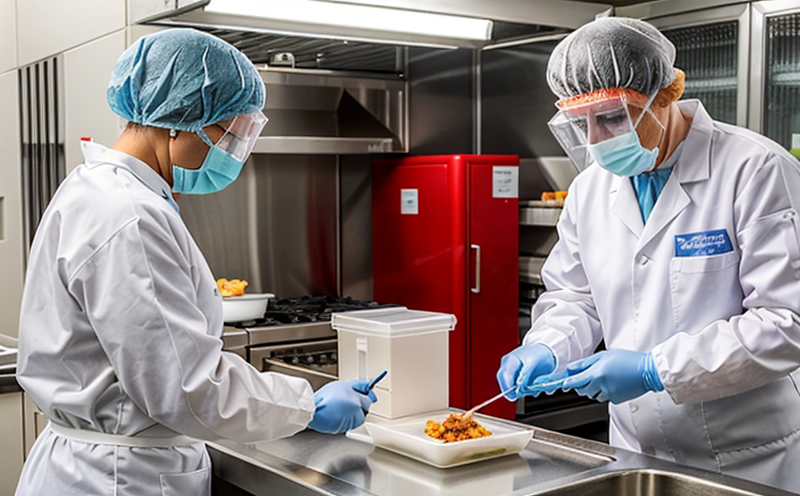USDA MLG 21.02 Molecular Screening for Norovirus in Ready-to-Eat Foods
The USDA Mandatory Laboratory Guidelines (MLG) Chapter 21, Section 21.02, provides a standardized approach to molecular screening of noroviruses in ready-to-eat foods. This service is critical in ensuring the safety and integrity of food products that are consumed without further preparation or cooking.
The USDA MLG 21.02 protocol ensures that laboratories adhere to stringent testing methodologies and quality control measures. By using this guideline, food producers can mitigate the risk of norovirus contamination, which is a leading cause of foodborne illness in ready-to-eat foods such as pre-packaged salads, sandwiches, and deli meats.
The test involves several steps that are designed to detect noroviruses at their earliest stages. This process ensures that contaminated products do not reach the consumer market, thereby protecting public health. The protocol is especially important for food items that have extended shelf lives or are sold in environments where cross-contamination can easily occur.
The USDA MLG 21.02 test focuses on detecting norovirus genotypes GI and GII in ready-to-eat foods. These genotypes are responsible for the majority of norovirus infections worldwide, making them critical targets for molecular screening. The test uses advanced polymerase chain reaction (PCR) techniques to amplify viral RNA from food samples and identify specific genetic sequences characteristic of noroviruses.
Sample preparation is a crucial step in this process. Food samples are thoroughly homogenized and then processed through nucleic acid extraction kits designed for high-throughput sample processing. This ensures that all necessary components are captured efficiently, minimizing the chances of false negatives or positives. Once extracted, the nucleic acids undergo reverse transcription to generate complementary DNA, which is then subjected to PCR amplification.
The use of real-time quantitative PCR (qPCR) allows for precise quantification and detection of norovirus RNA in food samples. This method provides accurate results even at low viral loads, making it an essential tool in ensuring the safety of ready-to-eat foods. The qPCR assay is validated against international standards such as ISO 17025 to ensure reliability and accuracy.
Post-PCR data analysis involves bioinformatics tools that interpret the amplification data to identify specific norovirus sequences. This process requires a deep understanding of viral genetics and molecular biology, ensuring that only genuine norovirus RNA is detected. The results are reported in terms of viral load per gram or milliliter of food sample, providing clear insights into contamination levels.
The USDA MLG 21.02 test is not just about identifying the presence of noroviruses; it also helps in understanding their distribution within a batch of food products. This information can be invaluable for traceability and recall efforts if contamination is detected. By implementing this protocol, food producers can maintain high standards of food safety and compliance with regulatory requirements.
The test is particularly relevant for ready-to-eat foods that are consumed without further preparation or cooking. These types of foods pose a higher risk of norovirus transmission due to their direct consumption and the potential for cross-contamination during production, packaging, and handling. The USDA MLG 21.02 protocol provides a robust framework for detecting noroviruses early in the supply chain, ensuring that contaminated products are identified and removed before they reach consumers.
By adhering to this protocol, food producers can demonstrate their commitment to consumer safety and compliance with regulatory standards. This not only protects public health but also enhances brand reputation and trust among customers.
Scope and Methodology
| Parameter | Description |
|---|---|
| Detection of Norovirus Genotypes | The test focuses on detecting norovirus genotypes GI and GII, which are responsible for the majority of foodborne norovirus infections. |
| Sample Preparation | Food samples are homogenized and processed through nucleic acid extraction kits to ensure efficient capture of all necessary components. |
| Reverse Transcription | The extracted nucleic acids undergo reverse transcription to generate complementary DNA for PCR amplification. |
| Polymerase Chain Reaction (PCR) | Real-time quantitative PCR is used to amplify viral RNA and identify specific genetic sequences characteristic of noroviruses. |
| Data Analysis | Bioinformatics tools are employed to interpret the amplification data and identify genuine norovirus RNA. |
Why Choose This Test
- Compliance with USDA MLG 21.02: Ensures adherence to the latest regulatory standards for molecular screening of noroviruses in ready-to-eat foods.
- Early Detection: Identifies norovirus contamination at its earliest stages, allowing for prompt corrective actions.
- Precision and Reliability: Utilizes advanced PCR techniques to ensure accurate detection even at low viral loads.
- Traceability: Provides detailed insights into the distribution of noroviruses within batches of food products.
- Risk Mitigation: Helps in minimizing the risk of norovirus transmission and protecting public health.
- Brand Reputation: Demonstrates a commitment to consumer safety and compliance with regulatory standards, enhancing brand reputation.
The USDA MLG 21.02 molecular screening for norovirus in ready-to-eat foods is an essential tool for food producers looking to maintain high standards of food safety and comply with regulatory requirements. By implementing this protocol, food producers can ensure the integrity and safety of their products while protecting public health.
Quality and Reliability Assurance
- Certified Technicians: Our team consists of certified technicians with expertise in molecular biology and PCR techniques.
- ISO 17025 Compliance: The test is validated against international standards to ensure reliability and accuracy.
- Digital Data Recording: All data is recorded digitally, ensuring accurate and traceable results.
- Quality Control Measures: Strict quality control measures are in place to minimize errors and ensure consistent results.
- Traceability: Detailed records of each test run allow for easy tracing and verification of results.
The USDA MLG 21.02 molecular screening for norovirus in ready-to-eat foods is underpinned by robust quality and reliability assurance measures. Our laboratory adheres to strict protocols and standards, ensuring that every test result is accurate, reliable, and traceable. This commitment to excellence ensures that food producers can trust our services and maintain their reputation for delivering safe and high-quality products.





